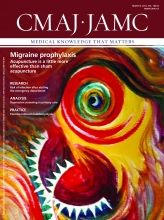Female feticide

Image courtesy of © 2012 Thinkstock
Canada should prohibit disclosure of the sex of a fetus until after about 30 weeks of pregnancy to combat female feticide, an evil that is practised by some ethnic groups in North America. See Editorial, page 387
Treating migraine
Four types of acupuncture, including a sham procedure, appeared to have similar effects in preventing migraine headache. This randomized controlled trial involving 480 people compared the number of days with migraine, as well as pain intensity, functional status and other secondary outcomes. The nonspecific effects of acupuncture may play a relevant role, say the authors. See Research, page 401
Although there seems to be little difference between Chinese and non-Chinese acupuncture points, Chinese points might be marginally more effective, says Molsberger. See Commentary, page 391

Image courtesy of © 2012 Thinkstock
Giving more training to family physicians on how to treat migraine did not improve patients’ symptoms. This pragmatic randomized controlled trial of six hours of training for doctors, and involving 490 patients, showed little difference in the frequency, severity or duration of attacks or number of days spent with headaches or away from work. Future interventions should target patients with frequent attacks who are not using preventive medication, say the authors. See Research, page E224
Risk of infection in hospital
Elderly residents of long-term care facilities who visited the emergency department were more than three times more likely to have an acute infection in the following week. This finding comes from a cohort study of 1269 residents of long-term care facilities that used chart review to assess infection and possible confounding factors. Additional precautions should be considered for residents following a visit to the emergency department, say Quach and colleagues. See Research, page E232
Screening for depression

Image courtesy of © 2012 Thinkstock
The prevalence of depression and the availability of easy-to-use screening tools make it tempting to endorse widespread screening for the disease. However, according to Thombs and colleagues, screening in primary care is costly and does not yet show evidence of benefit. It may also have unintended negative effects for some patients. As Canada’s guidelines are being updated, the authors write that recommendations to screen should require evidence of benefit that exceeds evidence of harm. See Analysis, page 413
Recurrent exercise-induced rhabdomyolysis
A previously healthy 29-year-old man presented with muscle aches and dark urine after a four-hour hockey game. He had experienced similar episodes about once a year since he was 13 years old. A careful history revealed clues that led to the diagnosis, which was confirmed by some simple laboratory tests. The authors review the diagnosis and management of single and recurrent episodes of rhabdomyolysis. See Practice, page 426
Acute-onset floaters and flashes

Usually caused by posterior vitreous detachment, acute-onset floaters and flashes are common in older adults and are usually benign. Because posterior vitreous detachment can progress to retinal detachment in a minority of cases, any patient with these symptoms and a defect in visual field or the presence of vitreous hemorrhage or pigment should be assessed by an ophthalmologist within 24 hours. See Practice, page 431
Tattoo reactions and sarcoidosis
Reactions in cosmetic tattoos can be the only sign of cutaneous sarcoidosis. If a patient presents with inflammatory changes in tattoos, the possibility of cutaneous or systemic sarcoidosis should be considered. A tissue biopsy can help make the diagnosis. See Practice, page 432








